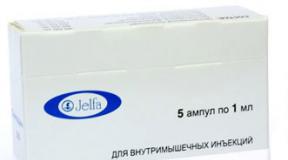What is the temperature in the apartment in winter. Sanitary standard temperature in apartments during the heating season
The efficiency of a heating system depends on many factors. These include rated power, heat transfer rate of radiators and temperature regime work. For the last indicator, it is important to correctly select the degree of heating of the coolant. Therefore, it is necessary to determine the optimal temperature in the heating system for water, radiators and boiler.
What determines the temperature of water in heating
For proper operation heating system requires a graph of water temperature in the heating system. According to it, the optimal degree of heating of the coolant is determined depending on the influence of certain external factors. From it you can determine what temperature of water in the heating radiators should be during a certain period of time the system is operating.
A common misconception is that the higher the degree of heating of the coolant, the better. However, this increases fuel consumption and increases operating costs.
Often low temperature heating batteries is not a violation of room heating standards. A low-temperature heating system was simply designed. That is why the accurate calculation of water heating should be given Special attention.
The optimal water temperature in heating pipes largely depends on external factors. To determine it, you need to take into account the following parameters:
- Heat loss at home. They are decisive for the calculation of any type of heat supply. Their calculation will be the first stage of heat supply design;
- Boiler characteristics. If the operation of this component does not meet the design requirements, the temperature of the water in the heating system of a private house will not rise to the required level;
- Material for making pipes and radiators. In the first case, it is necessary to use pipes with a minimum thermal conductivity. This will reduce heat losses in the system during transportation of coolant from the boiler heat exchanger to the radiators. For batteries, the opposite is important - high thermal conductivity. Therefore, the water temperature in the radiators central heating, made of cast iron, should be slightly higher than that of aluminum or bimetallic structures.
Is it possible to independently determine what temperature should be in the heating radiators? This depends on the characteristics of the system components. To do this, you should familiarize yourself with the properties of the batteries, boiler and heat supply pipes.
IN centralized system heating supply, the temperature of the heating pipes in the apartment is not an important indicator. It is important that the standards for heating air in living rooms are observed.
Heating standards in apartments and houses
In fact, the degree of heating of water in heating pipes and radiators is a subjective indicator. It is much more important to know the heat transfer of the system. It, in turn, depends on what minimum and maximum water temperatures in the heating system can be achieved during operation.

For autonomous heat supply, central heating standards are quite applicable. They are set out in detail in Resolution of the PRF No. 354. It is noteworthy that the minimum water temperature in the heating system is not indicated there.
It is only important to observe the degree of heating of the air in the room. Therefore, in principle, the operating temperature of one system may be different from another. It all depends on the influencing factors mentioned above.
In order to determine what temperature should be in the heating pipes, you should familiarize yourself with the current standards. Their contents are divided into residential and non-residential premises, as well as the dependence of the degree of air heating on the time of day:
- In the rooms during the daytime. In this case, the standard heating temperature in the apartment should be +18°C for rooms in the middle of the house and +20°C in the corner ones;
- In living rooms at night. Some reduction is allowed. But at the same time, the temperature of the heating radiators in the apartment should provide +15°C and +17°C, respectively.
Responsible for compliance with these standards Management Company. If they are violated, you can request a recalculation of payment for heating services. For autonomous heat supply, a table of temperatures for heating is made, where the values of heating of the coolant and the degree of load on the system are entered. However, no one bears responsibility for violating this schedule. This will affect the comfort of staying in a private home.
For centralized heating, it is mandatory to maintain the required level of air heating in staircases and non-residential premises. The water temperature in the heating radiators should be such that the air is heated to a minimum value of +12°C.
Calculation of temperature operating conditions of heating
When calculating heat supply, it is necessary to take into account the properties of all components. This is especially true for radiators. Which optimal temperature Should the heating radiators be +70°C or +95°C? It all depends on the thermal calculation, which is performed at the design stage.
First, it is necessary to determine the heat losses in the building. Based on the data obtained, a boiler with the appropriate power is selected. Then comes the most difficult design stage - determining the parameters of the heat supply batteries.
They must have a certain level of heat transfer, which will affect the temperature chart of the water in the heating system. Manufacturers indicate this parameter, but only for a certain operating mode of the system.
If to maintain a comfortable level of air heating in a room you need to spend 2 kW of thermal energy, then the radiators must have a no less heat transfer rate.
To determine this, you need to know the following quantities:
- The permissible maximum water temperature in the heating system ist1. It depends on the boiler power, temperature limit effects on pipes (especially polymer ones);
- Optimal the temperature that should be in the heating return pipes - t This is determined by the type of pipeline layout (one-pipe or two-pipe) and the total length of the system;
- The required degree of heating of the air in the room ist.
Tnap=(t1-t2)*((t1-t2)/2-t3)
Q=k*F*Tnap
Where k– heat transfer coefficient of the heating device. This parameter must be indicated in the passport; F– radiator area; Tnap– thermal pressure.
By varying various indicators of the maximum and minimum water temperature in the heating system, you can determine optimal mode system operation. It is important to correctly initially calculate the required power of the heating device. Most often, the low temperature indicator in heating radiators is associated with heating design errors. Experts recommend adding a small margin to the obtained radiator power value - about 5%. This will be needed in the event of a critical drop in outside temperature in winter period.
Most manufacturers indicate the heat output of radiators according to accepted standards EN 442 for mode 75/65/20. This corresponds to the normal heating temperature in the apartment.
Water temperature in the boiler and heating pipes
After performing the above calculation, it is necessary to adapt the heating temperature table for the boiler and pipes. During operation, heat supply should not occur emergency situations, common cause which is a violation of the temperature schedule.
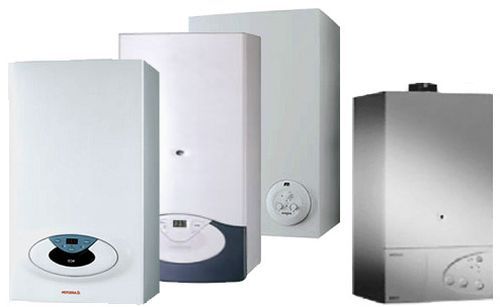
The normal water temperature in central heating radiators can be up to +90°C. This is strictly monitored at the stage of coolant preparation, its transportation and distribution to residential apartments.
The situation with autonomous heat supply is much more complicated. In this case, control completely depends on the owner of the house. It is important to ensure that there is no excess temperature of the water in the heating pipes that goes beyond the established schedule. This may affect the safety of the system.
If the water temperature in the heating system of a private home exceeds the norm, the following situations may occur:
- Damage to pipelines. This is especially true for polymer lines, where the maximum heating can be +85°C. That is why the normal temperature of heating pipes in an apartment is usually +70°C. Otherwise, deformation of the line may occur and a gust may occur;
- Excess air heating. If the temperature of the heating radiators in the apartment provokes an increase in the degree of air heating above +27°C, this is outside the normal limits;
- Reduced service life of heating components. This applies to both radiators and pipes. Over time, the maximum water temperature in the heating system will lead to breakdown.
Also, a violation of the water temperature schedule in the autonomous heating system provokes the formation air jams. This occurs due to the transition of the coolant from liquid to gaseous state. Additionally, this affects the formation of corrosion on the surface of the metal components of the system. That is why it is necessary to accurately calculate what temperature should be in the heat supply batteries, taking into account their material of manufacture.
Most often the violation thermal regime operation is observed in solid fuel boilers. This is due to the problem of adjusting their power. When a critical temperature level in the heating pipes is reached, it is difficult to quickly reduce the boiler power.
The influence of temperature on the properties of the coolant
In addition to the factors described above, the temperature of the water in the heating pipes affects its properties. This is the basis of the operating principle of gravity heating systems. As the heating level of water increases, it expands and circulation occurs.

However, if antifreeze is used, exceeding the normal temperature in the radiators can lead to different results. Therefore, for heating with a coolant other than water, you should first find out the permissible heating rates. This does not apply to the temperature of central heating radiators in the apartment, since such systems do not use antifreeze-based liquids.
Antifreeze is used if there is a possibility that low temperatures will affect radiators. Unlike water, it does not begin to change from a liquid to a crystalline state when it reaches 0°C. However, if the heat supply operation exceeds the norms of the temperature table for heating to a greater extent, the following phenomena may occur:
- Foaming. This entails an increase in the volume of coolant and, as a result, an increase in pressure. The reverse process will not be observed when the antifreeze cools;
- Formation limescale . Antifreeze contains a certain amount of mineral components. If the heating temperature in the apartment is violated, they begin to precipitate. Over time, this will lead to clogged pipes and radiators;
- Increasing the density index. There may be malfunctions circulation pump, unless its rated power was designed to withstand such situations.
Therefore, it is much easier to monitor the water temperature in the heating system of a private home than to control the degree of heating of antifreeze. In addition, when evaporating, ethylene glycol-based compounds emit gas that is harmful to humans. Currently, they are practically not used as a coolant in autonomous systems heat supply.
Before pouring antifreeze into the heating, you should replace all rubber gaskets with paranitic gaskets. This is due to the increased permeability of this type of coolant.
Methods for normalizing heating temperature
The minimum value of water temperature in the heating system is not main threat for her work. This, of course, affects the microclimate in residential premises, but in no way affects the functioning of the heat supply. If the water heating norm is exceeded, emergency situations may occur.

When drawing up a heating scheme, it is necessary to provide a number of measures aimed at eliminating a critical increase in water temperature. First of all, this will lead to an increase in pressure and an increase in load on inner surface pipes and radiators.
If this phenomenon is one-time and short-lived, the heat supply components may not be affected. However, such situations arise under the constant influence of certain factors. Most often this is a malfunction of the solid fuel boiler.
- Setting up a security group. It consists of an air vent, a bleed valve and a pressure gauge. If the water temperature reaches a critical level, these components will remove excess coolant, thereby ensuring normal circulation of the liquid for its natural cooling;
- Mixing unit. It connects the return and supply pipes. Additionally, a two-way valve with a servo drive is installed. The latter is connected to the temperature sensor. If the degree of heating exceeds the norm, the valve will open and the flow of hot and cooled water will mix;
- Electronic heating control unit. It records the water temperature at various areas systems. In the event of a violation of the thermal regime, it will send the appropriate command to the boiler processor to reduce power.
These measures will help prevent incorrect heating operation even further. initial stage occurrence of a problem. It is most difficult to regulate the water temperature level in systems with solid fuel boiler. Therefore, for them, special attention should be paid to the selection of parameters for the safety group and mixing unit.
The effect of water temperature on its circulation in heating is described in detail in the video:
In order to live comfortably in an apartment or country house during the winter, it is necessary to equip a heating system. If you live in the private sector, this may be an autonomous network, but if you live in an apartment building, then it is centralized. In any case, it is necessary that the battery temperature is within heating season complied with the standards provided for by law and the relevant SNiP.
When does the housing office carry out work on connecting batteries?
In Russia, the heating season begins when the average daily outside air temperature becomes below +8°C, and ends when it begins to exceed +8°C, and it must be maintained for up to five days.
Standards
Let's consider the minimum indoor temperature:
- In the living room +18°C;
- In the corner room +20°C;
- In the kitchen +18°C;
- In the bathroom +25°C;
- In the lobby and on the landing +16°C;
- In the elevator room +5°C;
- In the basement +4°C;
- In the attic +4°C.
This value is measured at interior wall each room, and from outer wall the distance should be 1 m, and from the floor 1.5 m.
If hourly deviations from standard parameters are noticed, then the heating fee should be reduced by 0.15%.
It should be noted that this temperature standard is valid after the opening of the heating season, and there are no indicators for the off-season.
It is also necessary to know that hot water must have a temperature from +50°C to +70°C (SNiP 2.08.01.89 “Residential buildings”).
It is measured by opening the tap and lowering the thermometer into the container to a special mark.
What to do if the batteries do not heat well?
If the radiators do not warm the room, then the water from the tap will be at a lower temperature, and residents can write an application to the DEZ requesting an inspection. After inspecting the water supply and heating system, utility workers draw up an act, one copy of which remains with the residents.
If the complaint is confirmed, specialists are obliged to correct everything within one day to a week.
Also, if the water temperature in the heating radiators was 3°C lower (during the day) and 5°C lower (at night) than the standard, then the rent is recalculated.
Radiators must warm the room to the degree specified in the sanitary norm, since deviations in air temperature are not allowed. And if this happens, then it is necessary to make a recalculation, according to which, depending on the square footage of the premises, the rent will be reduced.
Air ratio parameters
The room must have a certain air exchange rate, for example, if the room is residential and has an area of 18 or 20 m 2, then the rate should be 3 m 3 / h per square meter. m., the same parameters are also necessary in regions where the temperature reaches −31°C and drops below.
In dormitory kitchens and apartments equipped with electric and gas two-burner stoves and having an area of up to 18 m 2, aeration is 60 m 3 / h.
If there is a three-burner appliance in the room, then this value will be 75 m 3 / h, if there is a gas stove with four burners - 90 m 3 / h.
For a bathroom with an area of 25 m2, the air exchange rate should be 25 m3/h, and for an individual restroom with an area of 18 m2 - 25 m3/h. If the bathtub and toilet are combined and their area is 25 m 2, then the aeration is 50 m 3 / h.
If the common restroom has an area of 16 m2, then an air exchange rate of up to 50 m3 / h is required for one toilet, and 25 m3 / h for a urinal.
If the room is corner, then the room should be 2°C higher than usual.
During warm periods, the temperature in the elevator room should not exceed 40°C.
What is the temperature in the batteries?
There are certain parameters on this issue:
- To the taps all year round hot water must be supplied, the temperature of which should be from +50°C to +70°C;
- During the heating season, this liquid is completely filled heating devices.
Let's look at how to measure the temperature of a radiator; to do this, open the tap and place a container with a thermometer. In this case, deviations are only possible upward by +4°C.
If a problem arises in this matter, then you need to file a complaint with the Housing Office, but if the batteries are airy, then the application must be written to the DEZ. A specialist will come within a week and fix everything.
Several more methods for measuring the temperature of radiators:
- A thermometer measures the temperature of heating pipes or the surface of a radiator. Add 1 - 2°C to the resulting value;
- In order to make these measurements extremely accurately, purchase an infrared thermometer-pyrometer, which determines the temperature with an accuracy of 0.5 ° C;
- Take an alcohol thermometer and apply it to the selected place on the radiator, glue it with tape and wrap it with any heat-insulating material(foam rubber, flywheel). This is a permanent device for measuring the temperature of the heating system;
- If you have an electrical measuring device at home with the “measure temperature” function, then a wire with a thermocouple is wound to the battery and the temperature of the coolant is measured.
It is important! If the temperature of the heating radiators does not satisfy you, then a commission will come to you based on a complaint, which must measure the temperature of the circulating fluid in the heating system. Their actions must comply with paragraph 4, which is specified in the “Control Methods” of GOST 30494−96, and the measuring device must be registered, state tested and have a quality certificate. Its range should vary from +5 to +40°C, and an error of 0.1°C is also acceptable.
Regulations in force in Russia
Let's look at some parameters that depend on the outdoor temperature.
According to the Decree of the State Construction Committee dated September 27, 2003 No. 170, in the event that the coolant supply to heating device carried out from the bottom up, then the following norms are adopted, which are shown in the table:
| Outdoor air temperature (°C) | Return (in °C) | Supply pipe (in °C) |
| +5 | 39 | 50 |
| +4 | 41 | 53 |
| +3 | 43 | 56 |
| +2 | 45 | 59 |
| +1 | 46 | 62 |
| 0 | 48 | 65 |
| −1 | 50 | 67 |
| −2 | 51 | 70 |
| −3 | 53 | 73 |
| −4 | 54 | 76 |
| −5 | 56 | 78 |
It should also be taken into account that the temperature of the circulating fluid at the entrance of the heating system to the room must correspond to the schedule that regulates the utility network for a particular room.
According to SNiP - 41−01−2003 “Heating, ventilation and air conditioning”, which specifies standards not only for administrative, public, but also for residential buildings, it is emphasized that:
If the heating system is two-pipe, then the maximum coolant temperature should be +95°C, and if it is single-pipe, then +105°C.
Conclusion
For a comfortable stay in an apartment multi-story building, in a country house or cottage, it is necessary to equip the premises with a heating system. To do this, you need to know what temperature in the heating radiators is more favorable for creating comfort in the room.
All special parameters are indicated in different regulatory documents, and if for some reason they are not fulfilled, then the Housing Office considers the application or complaint and carries out appropriate control over the implementation of all necessary corrective work.
To feel comfortable in an apartment or in own home In winter, a reliable heating system that meets standards is required. IN multi-storey building- this is, as a rule, a centralized network, in private households - heating system. For the end consumer, the main element of any heating system is the battery. The coziness and comfort in the house depends on the heat coming from it. The temperature of the heating radiators in the apartment, its norm is regulated by legislative documents.
Radiator heating standards
If the house or apartment has autonomous heating, adjusting the temperature of the radiators and taking care of maintaining the thermal regime falls on the homeowner. In a multi-storey building with centralized heating The authorized organization is responsible for compliance with the standards. Heating standards are developed on the basis of sanitary standards that apply to residential and non-residential premises. The calculations are based on the needs of an ordinary body. Optimal values are established by law and reflected in SNiP.
The apartment will be warm and cozy only when the heat supply standards required by law are met.
When is heat connected and what standards apply?
The beginning of the heating season in Russia occurs at a time when the thermometer readings drop below +8°C. The heating is turned off when the mercury rises to +8°C and above, and remains at this level for 5 days.
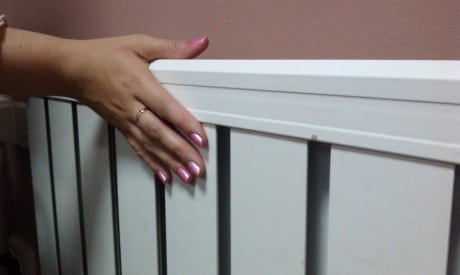
To determine whether the battery temperature meets the standards, it is necessary to take measurements
Minimum temperature standards
In accordance with heat supply standards, the minimum temperature should be as follows:
- living rooms: +18°C;
- corner rooms: +20°C;
- bathrooms: +25°C;
- kitchens: +18°C;
- landings and lobbies: +16°C;
- basements: +4°C;
- attics: +4°C;
- elevators: +5°C.
This value is measured indoors at a distance of one meter from external wall and 1.5 m from the floor. With hourly deviations from established standards heating fees are reduced by 0.15%. The water must be heated to +50°C – +70°C. Its temperature is measured with a thermometer, lowering it to a special mark in a container with tap water.

Standards according to SanPiN 2.1.2.1002-00
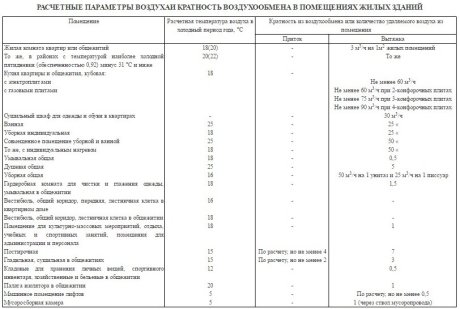
It’s cold in the apartment: what to do and where to go
If the radiators do not heat well, the water temperature in the tap will be lower than normal. In this case, residents have the right to write a statement requesting an inspection. Representatives of the utility service inspect the water supply and heating systems and draw up a report. The second copy is given to residents.
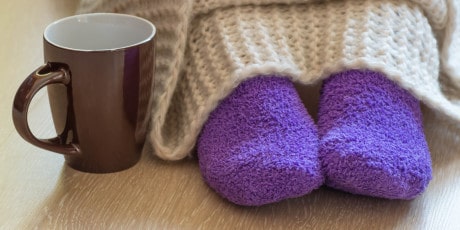
If the radiators are not warm enough, you need to contact the organization responsible for heating the house
If the complaint is confirmed, the authorized organization is obliged to correct everything within a week. Rent is recalculated if the room temperature deviates from permissible norm, and also when the water in the radiators during the day is below the standard by 3°C, at night - by 5°C.
Quality requirements utilities, prescribed in Resolution No. 354 of May 6, 2011 on the rules for the provision of utility services to owners and users of premises in apartment buildings And residential buildings
Air ratio parameters
The air exchange rate is a parameter that must be observed in heated rooms. In a living room with an area of 18 m² or 20 m², the multiplicity should be 3 m³/h per square meter. m. The same parameters must be observed in regions with temperatures down to -31°C and below.
In apartments equipped with gas and electric stoves with two burners, and dormitory kitchens with an area of up to 18 m², aeration is 60 m³/h. In rooms with a three-burner appliance, this value is 75 m³/h, s gas stove with four burners - 90 m³/h.
In a bathroom with an area of 25 m², this parameter is 25 m³/h, in a toilet with an area of 18 m² - 25 m³/h. If the bathroom is combined and its area is 25 m², the air exchange rate will be 50 m³/h.
Methods for measuring radiator heating
The taps are supplied with hot water all year round, heated to +50°C – +70°C. During the heating season, heating devices are filled with this water. To measure its temperature, open the tap and place a container under the stream of water, into which the thermometer is lowered. Deviations are allowed by four degrees upward. If a problem exists, file a complaint with the Housing Office. If the radiators are airy, the application must be written to the DEZ. A specialist should show up within a week and fix everything.

The presence of a measuring device will allow you to constantly monitor the temperature regime
Methods for measuring the heating of heating batteries:
- The heating of the pipe and radiator surfaces is measured with a thermometer. 1-2°C is added to the result obtained.
- For the most accurate measurements, an infrared thermometer-pyrometer is used, which determines readings with an accuracy of 0.5°C.
- A permanent measuring device can be an alcohol thermometer, which is applied to the radiator, glued with tape, and wrapped with foam rubber or other heat-insulating material on top.
- The heating of the coolant is also measured by electrical measuring instruments with the “measure temperature” function. To measure, a wire with a thermocouple is screwed to the radiator.

By regularly recording the device data and recording the readings in a photo, you will be able to file a claim against the heat supplier
Important! If the radiators do not heat up enough, after submitting an application to an authorized organization, a commission should come to you and measure the temperature of the liquid circulating in the heating system. The commission’s actions must comply with paragraph 4 of “Control Methods” in accordance with GOST 30494−96. The device used for measurements must be registered, certified and undergo state verification. Its temperature range should be from +5 to +40°С, the permissible error is 0.1°С.
Adjusting heating radiators
Adjusting the temperature of heating radiators is necessary in order to save on heating the room. In high-rise apartments, the heating bill will decrease only after installing a meter. If a private house has a boiler that automatically maintains a stable temperature, regulators may not be needed. If the equipment is not automated, the savings will be significant.
Why is adjustment needed?
Adjusting the batteries will help achieve not only maximum comfort, but also:
- Remove airing, ensure the movement of the coolant through the pipeline and transfer heat to the room.
- Reduce energy costs by 25%.
- Do not constantly open windows due to overheating of the room.
Heating adjustments must be made before the start of the heating season. Before this, you need to insulate all windows. In addition, the location of the apartment is taken into account:
- corner;
- in the middle part of the house;
- on the lower or upper floors.
- insulation of walls, corners, floors;
- hydro- and thermal insulation joining seams between panels.
Without these measures, adjustment will not be beneficial, since more than half of the heat will warm the street.

Insulation corner apartment will help reduce heat loss as much as possible
The principle of adjusting radiators
How to properly regulate heating batteries? To rationally use heat and ensure uniform heating, valves are installed on the batteries. With their help, you can reduce the water flow or disconnect the radiator from the system.
- In centralized heating systems of high-rise buildings with a pipeline through which coolant is supplied from top to bottom, it is impossible to regulate radiators. The upper floors of such houses are hot, the lower floors are cold.
- In a single-pipe network, coolant is supplied to each battery with return to central riser. The heat is distributed evenly here. Control valves are installed on the radiator supply pipes.
- IN two-pipe systems with two risers, the coolant is supplied to the battery and back. Each of them is equipped with a separate valve with a manual or automatic thermostat.
Types of control valves
Modern technologies allow the use of special control valves, which are heat exchangers shut-off valves, connected to the battery. There are several types of taps that allow you to regulate heat.
Operating principle of control valves
According to the principle of action they are:
- Ball, providing 100% protection against accidents. They can rotate 90 degrees, allow water to pass through or shut off the coolant.
- Standard budget valves without temperature scale. They partially change the temperature, blocking the access of the coolant to the radiator.
- With a thermal head that regulates and controls system parameters. There are mechanical and automatic.
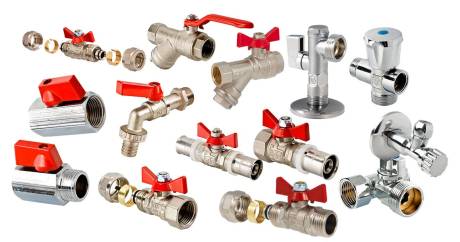
Exploitation ball valve comes down to turning the regulator to one side.
Note! The ball valve should not be left half-open, as this may damage the O-ring, resulting in a leak.
Conventional direct-acting thermostat
A direct-acting thermostat is a simple device installed near a radiator that allows you to control the temperature in it. Structurally, it is a sealed cylinder with a bellows inserted into it, filled with a special liquid or gas that can respond to temperature changes. Its increase causes expansion of the filler, resulting in increased pressure on the rod in the regulator valve. It moves and blocks the coolant flow. Cooling the radiator causes the opposite process.

A direct-acting thermostat is installed in the heating system pipeline
Thermostat with electronic sensor
The principle of operation of the device is similar to the previous version, the only difference is in the settings. In a conventional thermostat, they are performed manually, in electronic sensor the temperature is set in advance and maintained within specified limits (from 6 to 26 degrees) automatically.
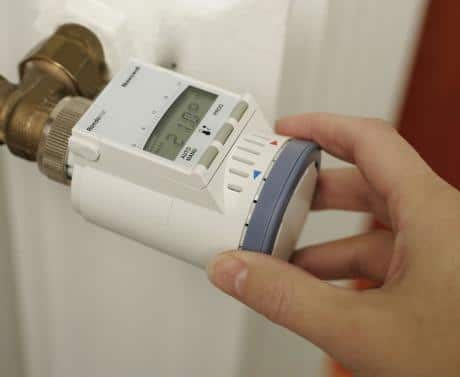
A programmable thermostat for heating radiators with an internal sensor is installed when it is possible to place its axis horizontally
Instructions for adjusting heat
How to regulate batteries, what actions need to be taken to ensure comfortable conditions in the house:
- Air is released from each battery until water flows from the tap.
- Pressure is adjustable. To do this, the valve in the first battery from the boiler opens two turns, in the second - three turns, etc., adding one turn for each subsequent radiator. This scheme ensures optimal coolant flow and heating.
- IN coercive systems pumping of coolant and control of heat consumption are carried out using control valves.
- Built-in thermostats are used to regulate heat in a flow-through system.
- In two-pipe systems, in addition to the main parameter, the amount of coolant is controlled in manual and automatic mode.
A selection of video stories on the topic
What is a thermal head for radiators needed for and how does it work:
Comparison of temperature control methods:
Comfortable accommodation in high-rise apartments, in country houses and cottages is ensured by maintaining a certain thermal regime in the premises. Modern systems heating systems allow you to install regulators that maintain the required temperature. If installing regulators is not possible, responsibility for the heat in your apartment rests with the heat supply organization, which you can contact if the air in the room does not warm up to the values required by the standards.















